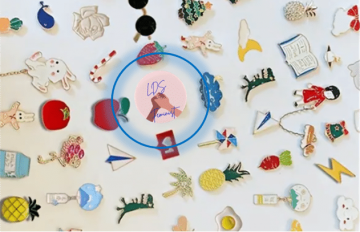It’s back to school time for my daughter and bookbag shopping with a tween is comical. She wanted one that was all black. Turns out, there are a lot of unacceptable shades, patterns, textures, and sizes of black backpacks. She wanted an all-black backpack so she could cover it with various pins and buttons. Pins from our summer travels, pins of things she loves, and buttons I donned in high school, and random tchotchkes she can hook on the zippers. The idea is to proclaim her middle school personality without saying a word. Once again, my daughter got me thinking.
I remember when I first found out there was still a “WE” in my Mormon feminist leanings. I went to BYU during the nineties and was in the Women’s Studies department, so I had a “we” in college. Discovering a collective of people who valued women, their experiences, their choices, their ideas, and a vision of equity was beyond inspiring. But then I left BYU, had a bunch of babies, went to church, and spent my out-of-church hours making laminated family home evening kits and hosting book clubs. My spiritual passion shifted. Needing to be part of a “we” I made my opinions known here and there, but always couched within my very disciplined, very comfortable-enough way. My feminism was never in doubt, nor did it fly under the radar, but it was given boundaries. I could be different, but I couldn’t be too different.
Then my babies started to leave the nest, life happened, and I felt this spiritual ache I wanted to explore. My ten-year-old son Sawyer had died, and I was navigating my grief and my relationship with my Heavenly Parents in the aftermath of that life-gutting, path-changing, personality-defining experience. I needed a God to love and love me and care for my heavenly child, but I was also livid with God for taking him from me and ruining the version of my life-including my spiritual life- I had spent so much time developing. I was so very, very conflicted. If I hadn’t been able to find “my people” before, this new, even more complicated outlook drove a wedge between me and the community I was seeking.
I remember when I first discovered the Exponent II blog. It was part of a confluence of events that opened my eyes to the fact that I might not be alone in my Mormon feminist leanings. Even though I wasn’t engaged in thought exercises with peers like I was in college anymore, there was a world of people who carried forth with these leanings, studies, dialogues, and discussions in a way I dreamed about, but had fallen to the back burner in the early days of my parenting. I had a childlike giddiness as I waited in my friend Annie‘s kitchen waiting for Bethany. Annie had invited one of her friends over. Annie had told me at church the previous week, “I have a friend from an old ward and I think the two of you would get along.” The three of us scheduled brunch and as we sat there telling the abbreviated versions of our lives for the short period our children were at preschool, magic settled into my heart. Two hours passed in the blink of an eye.
We talked about our joys, our concerns, our struggles, and our faith. My new friend told me about a couple of resources, including Exponent II, and all I could say was, “I haven’t talked like this about God and gospel doctrine since college. I’ve just felt sort of alone when it comes to my feminist faith nuances.” My new friend Bethany said, “I must talk to people about it. It sustains me. I need the support of others who question some of the crazy things people say from the pulpit, and who, in some nuanced way, think like me. I couldn’t do it alone.”
At that moment I realized I also couldn’t do it alone anymore either. (“It” being navigating my foundational feminist roots and my faith.) If our human bodies are made up of 60% water, feminism, and faith probably make up 60% of my spirit. They are inextricably linked to the core of who I am. After that brunch, I knew one of the paths of my current spiritual journey would require abandoning the “going it alone part” and finding community. I have been doing “it” alone, for decades. Let’s be clear, I have been a feminist my whole life, much to my mother’s chagrin. Especially during the middle school years when she wished I would blend in more at church than cause strife when the potluck didn’t have a vegetarian option. Or no one would answer my questions about Heavenly Mother. But even when I did try to blend in, I couldn’t. My brain and its accompanying need to speak up superseded the desire of my heart to just be one of the many.
American writer and leader Margaret J. Wheatley said, “There is no power for change greater than a community discovering what it cares about.” As a community of faithful feminists, LDS or not, I feel this organic growth of power to impact change inside and outside the LDS Church. We have collective strength and at this intersection of faith and feminism, especially as we individually continue to discover what we care most about. Let’s re-vitalize our gathering efforts to impact change. Whether it be institutional or in the lives of those worshipping around us. For the decades when I was in the throes of motherhood survival mode, I jumped on my Mormon Feminist soapbox as time, space, or egregious events allowed, but mostly, I did my own version of feminist worshiping. I regularly felt siloed in my nuance. I focused on raising my faithfully feminist children, making sure to speak up often, teaching them to do the same (as space allowed), but mostly, going it alone. I’ve kept my “slightly off” (and depending on the specific doctrine, majorly “off”) testimony mostly to myself. (See “Sisterhood of the Slightly Off”) I worked on doing the things, believing the words, and practicing the doctrine that felt good with my soul. At the time, I thought it felt easier than trying to find community.
A few days after brunch with my new friends, I had another lunch with someone I’d been acquaintances with at church. She was a Relief Society President from another ward and was very helpful to me in the aftermath of Sawyer’s death. At that awful time, she knew I was pretty isolated for a lot of different reasons. She reached out to me, comforted me, and provided me with love from a distance or close and personal as needed. As we occasionally talked about Church issues, we started growing in safety and comfort with each other, and the fear of judgment melted away. We proceeded to have these enlightening and liberating conversations. She and I had eaten lunch together once or twice, we’d interacted at a church occasionally, toss in a couple of service projects together, but that was about all. I had no idea this secret Mormon feminist paraded just under the surface of her Downeast dress. She, too, suggested the Exponent II blog.
After these two encounters, I did a deep dive into the archives of the Exponent II blog and found this ebb and flow of knowledge around doubt and belief, gender and religion, feminism and faith, and the intersections of all of it. This public collection of voices, highlighting and dissecting so many different ideas near and dear to my heart, I got lost in it all. People were talking about things that I hadn’t discussed since college, or with my closest friends when our capacity wasn’t exceeded with child-rearing, jobs, marriage, and life. I was in heaven. I felt the fire of my testimony burning because I wasn’t having to skate along, frustrated by so many narratives each week that often didn’t sit well with me.
There I was, stumbling across signposts I’d needed to help me on my faith journey and I didn’t even know I’d needed them. If I’m being totally honest, I wasn’t looking. I wish I’d been paying better attention so I wouldn’t have missed badges, the buttons, the signs, the people of the community of Saints questioning and committing to change. I wish I’d been looking along the way because I think my worship could have been deeper, more fulfilling, and more authentic. Ultimately, I think I’d have been less lonely in my spiritual experiences.
A young newly married woman came up to me to ask me about my nose ring one Sunday. I explained to her that it was an outward expression of my inward rebellion. As we started talking, she said she would like to get me know me because she was struggling with some aspects of her church experience. She said my nose ring was a hint that maybe I wasn’t going to judge her. I invited her to my house one evening for dinner and as we started talking, I felt this overwhelming sense of sisterhood. I imagined what my faith journey could have looked like as a young person, a young mother, and now middle-aged woman if I had throngs of women empowering me in my testimony. Particularly around the beliefs that women and men are all created equally. That we have a loving Heavenly Mother that we are not ashamed of who we speak of with reverence, not revisionism. If I had grown up better understanding that there are women in the scriptures other than Esther and Mary because their stories were at the center of the discussions, not left to the margins. Instead of making me sad that those influences were absent, this interaction with the woman from my ward reminded me that we have power in the stories we tell and the ways we share them.
On the heels of this interaction, I went to my oldest son’s graduation at BYU. I started talking with a woman he’d played pickleball with regularly. This woman was more my age and served as an interim aunt while he was away from home. Once after a game, she started talking about a post she’d read that had her thinking about some concerns she was having as a temple worker. She talked about how the post inspired her and how she wanted to talk about it, but she had no one to share her thoughts about it with. She said, “If I brought this up to anyone in my ward, they would look at me like I was crazy. I can’t bring it up in Sunday School or Relief Society. I am a temple worker for heaven’s sake. I can’t have people thinking I am a doubter.” My son said to her, “I think my mom wrote that post. You should talk to her.” So, at his graduation party, this proxy aunt of his and I spoke about things near and dear to our feminist hearts.
After the conversation ended, it percolated inside me for weeks. It bothered me so much that I ended up reaching out to this woman. We exchanged some emails, but mostly it didn’t go anywhere. When I talked to my son about her several months later, he said, “Mom, she has left the church. She didn’t want to let you down, so she stopped responding to your emails. She didn’t know how to tell you.” Instantly I knew that I was the one who let her down. In all of our conversations, I assume acceptance was implied. She didn’t know me well and didn’t know that her journey was hers, and that I loved her and would listen to her and accept her no matter where her faith journey took her, I just wanted to be a thought partner when she needed it along the way.
At that moment, I reaffirmed my commitment to being a listening ear and a non-judgmental heart to other women inside and outside the LDS church who need to have the space to talk about the heavy things. Ideas that make some of the Relief Society sisters squirm and cause the teacher to look away when you bring them up in Sunday School. The problem is, I can’t take out an advertisement in the program, “Offered: One cis-gender white woman, willing to talk about all things controversial at church but heavy on your heart. She will never judge, will always love, and will be a voice in the darkness. Also, she will be doling out the “LDS4Harris” stickers in the kitchen after the Munch and Mingle.” Mostly because we don’t do printed programs anymore and a QR code for LDS Feminists feels a smidge over the top.
I have thought long and hard about how we collectively make our willingness to engage in feminist thought and deed known to those around us. We need a logo, a sign, or a symbol-a pin on our oversized church bags-to wear proclaiming we are safe. And then we have to BE safe. We could show marginalized congregants looking for allies where our heart lies, without saying a word. We need pins. Buttons. Badges. Our own version of the Mockingjay pin, for the Hunger Games fans out there. Something that we can all put on our lapels to convey things like, “Hey, I want to talk about what we are going to do to make our ward less homophobic,” or “Let’s have a debrief of the lesson on how women’s work is only valued when it’s not monetized,” or whatever it may be. Until we collectively place our bulk order, I guess we will have to use our actual voices instead. Especially during this upcoming political season. Let’s build a sisterhood that will sustain a sainthood that is inclusive, inspiring, and committed to growing together so no one has to go it alone.
PS-For those interested in actual buttons, well, I don’t have them. But I do have 100 “LDS4HARRIS” stickers designed, printed, and en route to my house for those so inclined. Holler if you want one. Let’s flood church parking lots nationally without saying a word.








16 Responses
This made me cry “Offered: One cis-gender white woman, willing to talk about all things controversial at church but heavy on your heart. She will never judge, will always love, and will be a voice in the darkness.” Thank you for being that person for those around you and for sharing with us.
I loved this too. Made me feel less alone. This is such a crucial role.
If you’re ever in Virginia, holler! We should break bread.
Where in Virginia? Can I join in?
Always. Thank you for your words.
Fabulous post. Thank you. I know we aren’t allowed to advertise on church bulletins anymore but you should totally print these “offered” posters out and paste them all over.🤍 And I want a LDS4Harris sticker!!
I’m here for plastering the mother’s lounges, parking lots, all the places! Message me a mailing address and I will throw one in the mail. @jaime.clemmer
Loved this, but the font was pale and very difficult to read.
Thanks for the feedback. Sorry about the font color. I will go back in and make sure it is in black.
“Outward expression of inward rebellion” for the win! Love it.
This post reminds me of the Dar Williams song “You’re Aging Well”.
https://youtu.be/p0FuXfpxM1Y?feature=shared
I adore Dar so this is an amazing compliment. Thank you!
“Outward expression of inward rebellion” is so relatable to me. When I started struggling with certain aspects of my religious life (some may have called this a shelf-breaking moment), I bought an earring cuff. I didn’t even need another piercing for it. As I bought it, I could hear the voice of a particularly monstrous YW leader from my youth muttering about “the appearance of evil.” But it’s the cutest little cuff, and I wear it to church, and it reminds me that every Sunday it is my choice to express my faith how I want.
I have a couple more cuffs now so I can change it up, but that first cuff is still my favorite.
I do wish we could have a way to say “this person is safe! Come to them!” It would make such a difference for me. Instead we are left with “black market feminism” where we identify each other by pins and subtle comments in church. At an institute lunch, I made a comment about working women. Afterwards, a friend came up to me and explained that she and several women in the area met for “faith and feminism” discussions, and she thought I might be interested. It was awesome. But I couldn’t have just asked when I moved to the area “excuse me, where is the feminist club?”
Oooh, maybe when someone new moves in I should start asking them if they are a member of the feminist club. It could save a lot of months or years of awkward social encounters.
I like it! See-we need buttons! 🙂
There are so many things about this article that I love, it is hard to pick one to comment on. My own personal outward expression of an inward rebellion was at kind of the height of the push for women to have only one ear piercing, I went out and got a second hole punched. It wasn’t really that I wanted to wear two pair of earrings at the same time, it was I was so sick of the church trying to dictate the minute details of women’s dress and style. But, we feminists do need some sort of code in our dress that helps us identify each other, maybe like the gays have handkerchiefs in their back pocket to signal what they are into, we could have color coded earrings. Then we can declare our loyalties with our multiple earrings. Oh, say white stud for giving women the priesthood because then we will have a vote in church government because white was the color for women’s suffrage. A black stud could be for death to the patriarchy. A gold stud for us golden girls who started with feminism back with the ERA and Sonia Johnson. Maybe red could be for those of us quite open to discussion of church problems and things that threaten a traditional testimony, while blue could be for a more loyal testimony. Two red studs could be for any still in the church but no longer believe. Light blue for wanting more information about Mother in Heaven because light blue is Mary’s traditional color and Mary is Jesus’s Mother.
I definitely want one of those LDS 4 Harris Walz stickers!